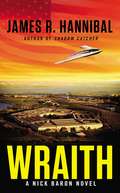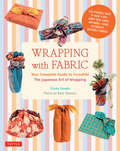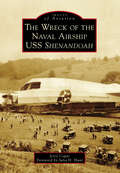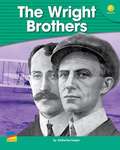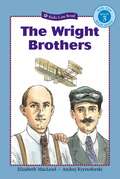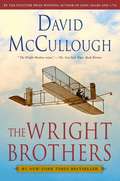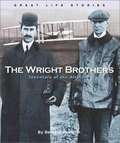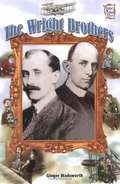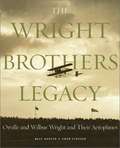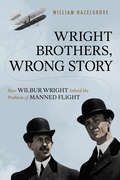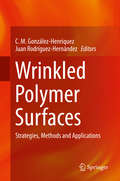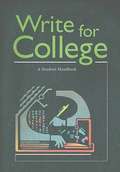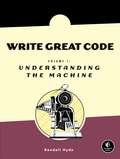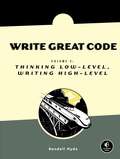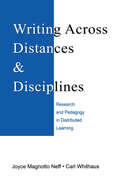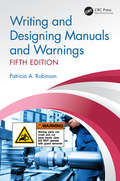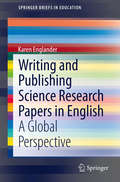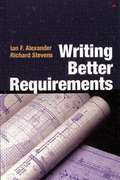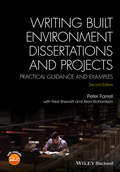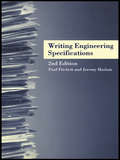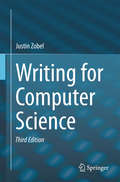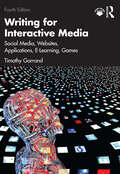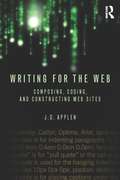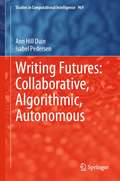- Table View
- List View
Wraith
by James R. HannibalAfter the towers fall on 9/11, Lieutenant Nick Baron and the rest of the 81st Fighter Squadron are desperate for action. But CENTCOM puts them on the sidelines, leaving the young Warthog pilots restless--and reckless. Then the unthinkable happens. During a high-risk training flight, a rookie wingman slams into the ground. In the darkness that follows, Nick wonders if he will ever learn to trust a wingman again--or even learn to trust himself. He will soon find out. Despite the black mark on his record, Nick's application to the elite Stealth Wing is approved. A recruiter for a new covert team has taken note of Nick's unique combination of skills. Suddenly Nick is swept into Operation Cerberus--a top secret mission that will take him from a harrowing flight over a black testing facility to a fight for his life on the Iraqi Dunes. "Hannibal brings together a terrific mix of real air technology with intrigue and nonstop action. A true suspenseful story that will keep you turning the pages until the exciting finale; it really is a great tale."--Clive Cussler "Get out of the way, Nelson DeMille. Brad Thor--you've got competition!"--Raymond Benson "A feast for thriller lovers!"--Grant Blackwood, New York Times bestselling author of The Kill Switch INCLUDES A PREVIEW OF SHADOW CATCHER James R. Hannibal (Lt Col, USAF Reserve), author of Shadow Maker and Shadow Catcher, is a graduate of the U.S. Air Force Academy who has flown the A-10 Warthog, the MQ-1 Predator drone, and the top secret B-2 Stealth Bomber, totaling over a thousand combat and combat support hours. He regularly reviews terrorism-related nonfiction for the New York Journal of Books.
Wrapping with Fabric
by Etsuko YamadaWrap anything from a wine bottle to a yoga mat with this practical Japanese fabric-wrapping book. Long before today's eco-friendly philosophy of "reduce, reuse, recycle" entered America's collective consciousness, furoshiki—the Japanese method of wrapping things with fabric—?ourished as a time-honored and practical art form. In Wrapping With Fabric, Etsuko Yamada—born into a long-line of furoshiki makers in Kyoto—explains the "one cloth, many uses" ideology behind the craft, the etiquette of color and the craft's fascinating history. From there, she shares the myriad ways in which a few basic techniques can transform a simple square of cloth into an elegant wrapper. Use your folded fabrics to: Gift-wrap anything from books to flowers Bundle up a picnic Tote items ranging from wine bottles to yoga mats Use as a handbag or backpack Make into a pillow covering Create decorative coverings for vases, tissue boxes, and more A quiet reminder that opportunities for artistry are everywhere around you, Wrapping With Fabric is the craft book that makes it easy to bring a touch of grace and ingenuity to everyday life—and help preserve the environment, too.
Wreck of the Naval Airship USS Shenandoah, The (Images of Aviation)
by Jerry Copas Julia H. HuntThe USS Shenandoah was the pride of the American Navy in 1925 and America�s first rigid dirigible. Her name is a Native American word often said to mean �Daughter of the Stars.� While performing a publicity tour in the Midwest, the ship was ripped to pieces by a violent storm. Fourteen men died, including Lt. Comdr. Zachary Landsowne, who remained at his post to the very end. The citizens of Noble County, Ohio, were alarmed and amazed when this high-tech, state-of-the-art marvel came tumbling out of the sky into their rural and isolated community. While lavishing care and support on the wounded, the locals also looted the wreckage and made souvenirs of valuable equipment that remained family treasures for years. Tales of daring heroism and sacrifice by those brave sailors on that stormy night soon became the thing of legend to the residents of the valley. For nearly 100 years, people there have maintained the legacy of Shenandoah with monuments, songs, and commemorations that continue to this day.
Wrestle the Mountain
by Phyllis Reynolds NaylorFrustrated by the narrowness of his West Virginia mining town, a boy with a talent for woodcarving yearns for a different way of life.
The Wright Brothers
by Elizabeth MacleodMeet the Wright Brothers -- inventors of the airplane. The story of how they created one of the most influential machines in history is told in level-appropriate language.
The Wright Brothers: The Dramatic Story-behind-the-story
by David McculloughTwo-time winner of the Pulitzer Prize David McCullough tells the dramatic story-behind-the-story about the courageous brothers who taught the world how to fly: Wilbur and Orville Wright.On a winter day in 1903, in the Outer Banks of North Carolina, two unknown brothers from Ohio changed history. But it would take the world some time to believe what had happened: the age of flight had begun, with the first heavier-than-air, powered machine carrying a pilot.Who were these men and how was it that they achieved what they did?David McCullough, two-time winner of the Pulitzer Prize, tells the surprising, profoundly American story of Wilbur and Orville Wright.Far more than a couple of unschooled Dayton bicycle mechanics who happened to hit on success, they were men of exceptional courage and determination, and of far-ranging intellectual interests and ceaseless curiosity, much of which they attributed to their upbringing. The house they lived in had no electricity or indoor plumbing, but there were books aplenty, supplied mainly by their preacher father, and they never stopped reading.When they worked together, no problem seemed to be insurmountable. Wilbur was unquestionably a genius. Orville had such mechanical ingenuity as few had ever seen. That they had no more than a public high school education, little money and no contacts in high places, never stopped them in their "mission" to take to the air. Nothing did, not even the self-evident reality that every time they took off in one of their contrivances, they risked being killed.In this thrilling book, master historian David McCullough draws on the immense riches of the Wright Papers, including private diaries, notebooks, scrapbooks, and more than a thousand letters from private family correspondence to tell the human side of the Wright Brothers' story, including the little-known contributions of their sister, Katharine, without whom things might well have gone differently for them.chievement.
The Wright Brothers: Inventors of the Airplane (Great Life Stories)
by Bernard Ryan Jr.The Wright Brothers were an amazing team who created one of the most revolutionary inventions of the twentieth century -- the airplane. Sons of a minister, Orville and Wilbur Wright were bright, industrious, and inseparable. As young men, they operated a print shop, published newspapers, and fixed and built bicycles. Orville and Wilbur began to actively pursue their dream of flying in the late 1890s. They built their first glider in 1900 and took it to Kitty Hawk, North Carolina, to test it. Three years later, Orville made the historic first flight on December 17. Their invention brought them much international attention. In 1909, they established the Wright American Company to build and sell their airplanes. Today, the Wright brothers are considered pioneers in the field of aviation. Book jacket.
The Wright Brothers Legacy: Orville and Wilbur Wright and Their Aeroplanes
by Walt Burton Owen FindsenFrom their early experiments with gliders to the first flight of a heavier-than-air aircraft, from their tours of European and American air shows to their development of a military aircraft to the final installation of the Kitty Hawk Flyer at the Smithsonian Institution in 1948, this volume celebrates an invention that changed the world.
Wright Brothers, Wrong Story: How Wilbur Wright Solved the Problem of Manned Flight
by William HazelgroveThis book is the first deconstruction of the Wright brothers myth. They were not -- as we have all come to believe--two halves of the same apple. Each had a distinctive role in creating the first "flying machine."How could two misanthropic brothers who never left home, were high-school dropouts, and made a living as bicycle mechanics have figured out the secret of manned flight? This new history of the Wright brothers' monumental accomplishment focuses on their early years of trial and error at Kitty Hawk (1900-1903) and Orville Wright's epic fight with the Smithsonian Institute and Glenn Curtis. William Hazelgrove makes a convincing case that it was Wilbur Wright who designed the first successful airplane, not Orville. He shows that, while Orville's role was important, he generally followed his brother's lead and assisted with the mechanical details to make Wilbur's vision a reality. Combing through original archives and family letters, Hazelgrove reveals the differences in the brothers' personalities and abilities. He examines how the Wright brothers myth was born when Wilbur Wright died early and left his brother to write their history with personal friend John Kelly. The author notes the peculiar inwardness of their family life, business and family problems, bouts of depression, serious illnesses, and yet, rising above it all, was Wilbur's obsessive zeal to test out his flying ideas. When he found Kitty Hawk, this desolate location on North Carolina's Outer Banks became his laboratory. By carefully studying bird flight and the Rubik's Cube of control, Wilbur cracked the secret of aerodynamics and achieved liftoff on December 17, 1903. Hazelgrove's richly researched and well-told tale of the Wright brothers' landmark achievement, illustrated with rare historical photos, captures the excitement of the times at the start of the "American century."
Wrinkled Polymer Surfaces: Strategies, Methods and Applications
by C. M. González-Henríquez Juan Rodríguez-HernándezThis book presents the state of the art in surface wrinkling, including current and future potential applications in biomedicine, tissue engineering, drug delivery, microfluidic devices, and other promising areas. Their use as templates, flexible electronics, and supports with controlled wettability and/or adhesion for biorelated applications demonstrate how the unique characteristics of wrinkled interfaces play a distinguishing and remarkable role. The fabrication approaches employed to induce wrinkle formation and the potential to fine-tune the amplitude and period of the wrinkles, their functionality, and their final morphology are thoroughly described. An overview of the main applications in which these buckled interfaces have already been employed or may have an impact in the near future is included. Presents a detailed description of the physical phenomena and strategies occurring at polymer surfaces to produce wrinkled surface patterns;Examines the different methodologies to produce morphology-controlled wrinkled surface patterns by means of physical and chemical treatment methods;Provides clear information on current and potential applications in flexible electronics and biomaterials, which are leading the use of these materials.
Write For College: A Student Handbook
by Patrick Sebranek Verne Meyer Dave KemperWrite for College emphasizes the kinds of writing that will prepare you for college course work. However, the handbook covers much more than writing. It also provides information and guidelines for speaking, thinking, critical reading, note taking, test taking, researching, and nearly every other topic essential to success.
Write Great Code, Volume 1: Understanding the Machine
by Randall HydeToday's programmers are often narrowly trained because the industry moves too fast. That's where Write Great Code, Volume 1: Understanding the Machine comes in. This, the first of four volumes by author Randall Hyde, teaches important concepts of machine organization in a language-independent fashion, giving programmers what they need to know to write great code in any language, without the usual overhead of learning assembly language to master this topic. A solid foundation in software engineering, The Write Great Code series will help programmers make wiser choices with respect to programming statements and data types when writing software.
Write Great Code, Volume 2: Thinking Low-Level, Writing High-Level
by Randall HydeIt's a critical lesson that today's computer science students aren't always being taught: How to carefully choose their high-level language statements to produce efficient code. Write Great Code, Volume 2: Thinking Low-Level, Writing High-Level shows software engineers what too many college and university courses don't - how compilers translate high-level language statements and data structures into machine code. Armed with this knowledge, they will make informed choices concerning the use of those high-level structures and help the compiler produce far better machine code - all without having to give up the productivity and portability benefits of using a high-level language.
Writing Across Distances and Disciplines: Research and Pedagogy in Distributed Learning
by Joyce Magnotto Neff Carl WhithausWriting Across Distances and Disciplines addresses questions that cross borders between onsite, hybrid, and distributed learning environments, between higher education and the workplace, and between distance education and composition pedagogy. This groundbreaking volume raises critical issues, clarifies key terms, reviews history and theory, analyzes current research, reconsiders pedagogy, explores specific applications of WAC and WID in distributed environments, and considers what business and education might teach one another about writing and learning. Exploring the intersection of writing across the curriculum, composition studies, and distance learning , it provides an in-depth look at issues of importance to students, faculty, and administrators regarding the technological future of writing and learning in higher education.
Writing and Designing Manuals and Warnings, Fifth Edition
by Patricia A. RobinsonTechnology is changing the way we do business, the way we communicate with each other, and the way we learn. This new edition is intended to help technical writers, graphic artists, engineers, and others who are charged with producing product documentation in the rapidly changing technological world. While preserving the basic guidelines for developing manuals and warnings presented in the previous edition, this new edition offers new material as well, including a much-expanded section on hazard analysis. Features Provides more explicit guidance on conducting a hazard analysis, including methods and documentation Offers in-depth discussion of digital platforms, including video, animations, and even virtual reality, to provide users with operating instructions and safety information Incorporates current research into effective cross-cultural communication—essential in today’s global economy Explains new US and international standards for warning labels and product instructions Presents expanded material on user analysis, including addressing generational differences in experience and preferred learning styles Writing and Designing Manuals and Warnings, Fifth Edition explores how emerging technologies are changing the world of product documentation from videos to virtual reality and all points in between.
Writing and Publishing Science Research Papers in English
by Karen EnglanderThis book provides a comprehensive review of the current knowledge on writing and publishing scientific research papers and the social contexts. It deals with both English and non-Anglophone science writers, and presents a global perspective and an international focus. The book collects and synthesizes research from a range of disciplines, including applied linguistics, the sociology of science, sociolinguistics, bibliometrics, composition studies, and science education. This multidisciplinary approach helps the reader gain a solid understanding of the subject. Divided into three parts, the book considers the context of scientific papers, the text itself, and the people involved. It explains how the typical sections of scientific papers are structured. Standard English scientific writing style is also compared with science papers written in other languages. The book discusses the strengths and challenges faced by people with different degrees of science writing expertise and the role of journal editors and reviewers.
Writing Better Requirements
by Richard Stevenson Ian F. AlexanderIf you are involved in the systems engineering process in any company, you will learn how to write requirements to get the system you want.
Writing Built Environment Dissertations and Projects: Practical Guidance and Examples
by Fred Sherratt Alan Richardson Peter FarrellWriting Built Environment Dissertations and Projects will help you to write a good dissertation or project by giving you a good understanding of what should be included, and showing you how to use data collection and analysis tools in the course of your research. Addresses prominent weaknesses in under-graduate dissertations including weak data collection; superficial analysis and poor reliability and validity Includes many more in-depth examples making it easy to understand and assimilate the concepts presented Issues around study skills and ethics are embedded throughout the book and the many examples encourage you to consider the concepts of reliability and validity Second edition includes a new chapter on laboratory based research projects Supporting website with sample statistical calculations and additional examples from a wider range of built environment subjects
Writing Engineering Specifications
by Paul Fitchett Jeremy HaslamEngineers need to understand the legal and commercial context in which they draw up technical specifications. This thoroughly up-dated edition of Haslam's successful Writing Engineering Specifications provides a concise guide to technical specifications and leads the reader through the process of writing these instructions, with clear advice to help the student and professional avoid legal disputes or the confusion and time wasting caused by poor drafting. Designers and project managers should find this invaluable, and it should be helpful to insurers, lawyers, estimators and the like.
Writing for Computer Science
by Justin ZobelAll researchers need to write or speak about their work, and to have research that is worth presenting. Based on the author's decades of experience as a researcher and advisor, this third edition provides detailed guidance on writing and presentations and a comprehensive introduction to research methods, the how-to of being a successful scientist. Topics include: · Development of ideas into research questions; · How to find, read, evaluate and referee other research; · Design and evaluation of experiments and appropriate use of statistics; · Ethics, the principles of science and examples of science gone wrong. Much of the book is a step-by-step guide to effective communication, with advice on: · Writing style and editing; · Figures, graphs and tables; · Mathematics and algorithms; · Literature reviews and referees' reports; · Structuring of arguments and results into papers and theses; · Writing of other professional documents; · Presentation of talks and posters. Written in an accessible style and including handy checklists and exercises, Writing for Computer Science is not only an introduction to the doing and describing of research, but is a valuable reference for working scientists in the computing and mathematical sciences.
Writing for Interactive Media: Social Media, Websites, Applications, e-Learning, Games
by Timothy GarrandThis thoroughly revised fourth edition teaches students and professionals how to create interactive content for all types of new media and become successful writers or designers in a variety of fields. This comprehensive guide is grounded in the core principles and skills of interactive media writing, in which writers create text and structure content to guide users through interactive products such as websites or software. The book examines case studies on interactive formats including complex informational websites, computer games, e-learning courses, training programs, and immersive exhibits. These case studies assess real-world products and documentation used by professional writers such as scripts, outlines, screenshots, and flowcharts. The book also provides practical advice on how to use interactive media writing skills to advance careers in the social media, technical, instructional communication, and creative media fields. This edition includes new chapters on UX Writing and Content Design, Social Media Writing, and Writing for Mobile. Writing for Interactive Media prepares students for the writing challenges of today’s technology and media. It can be used as a core textbook for courses in UX Writing, Writing for Digital Media, and Technical and Professional Communication and is a valuable resource for writing professionals at all levels. Supplemental resources include a sample syllabus, class assignments, student exercises, scripts, outlines, flowcharts, and other interactive writing samples. They are available online at www.routledge.com/9781032554242
Writing for the Web: Composing, Coding, and Constructing Web Sites
by J. D. ApplenWriting for the Web unites theory, technology, and practice to explore writing and hypertext for website creation. It integrates such key topics as XHTML/CSS coding, writing (prose) for the Web, the rhetorical needs of the audience, theories of hypertext, usability and architecture, and the basics of web site design and technology. Presenting information in digestible parts, this text enables students to write and construct realistic and manageable Web sites with a strong theoretical understanding of how online texts communicate to audiences. Key features of the book include: Screenshots of contemporary Web sites that will allow students to understand how writing for and linking to other layers of a Web site should work. Flow charts that describe how Web site architecture and navigation works. Parsing exercises in which students break down information into subsets to demonstrate how Web site architecture can be usable and scalable. Detailed step-by-step descriptions of how to use basic technologies such as file transfer protocols (FTP). Hands-on projects for students to engage in that allow them to connect the various components in the text. A companion website with downloadable code and additional pedagogical features: www.routledge.com/cw/applen ? Writing for the Web prepares students to work in professional roles, as it facilitates understanding of architecture and arrangement of written content of an organization’s texts.
Writing Futures: Collaborative, Algorithmic, Autonomous (Studies in Computational Intelligence #969)
by Ann Hill Duin Isabel PedersenThis book is useful to understand and write alongside non-human agents, examine the impact of algorithms and AI on writing, and accommodate relationships with autonomous agents. This ground-breaking future-driven framework prepares scholars and practitioners to investigate and plan for the social, digital literacy, and civic implications arising from emerging technologies. This book prepares researchers, students, practitioners, and citizens to work with AI writers, virtual humans, and social robots. This book explores prompts to envision how fields and professions will change. The book’s unique integration with Fabric of Digital Life, a database and structured content repository for conducting social and cultural analysis of emerging technologies, provides concrete examples throughout. Readers gain imperative direction for collaborative, algorithmic, and autonomous writing futures.
